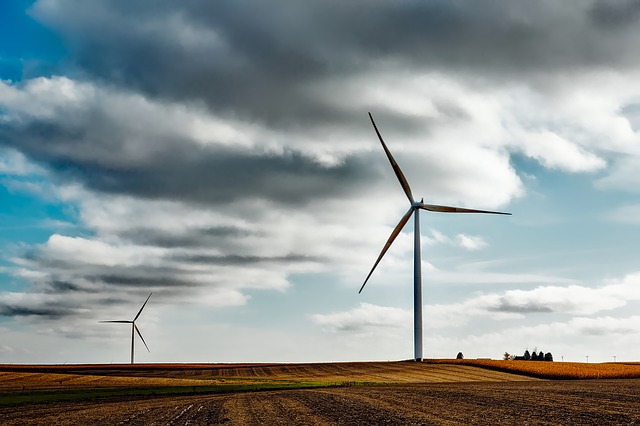
The Economic Benefits of Renewable Energy
Read a summary using the INOMICS AI tool
In 2018, United States President Donald Trump said his administration was putting more coal miners back into work, having previously rattled on about how important coal jobs were to the future of the US. Perhaps it should be no surprise that his words were empty. The Trump administration has added a negligible 2,000 coal mining jobs since it took control, and whatever bump in coal production 2018 saw was quick to fade away. Obviously, Trump’s pledge to keep the industry alive was a political stunt, not a decision based on the economic realities of the moment; for if it had been, Trump wouldn’t have been talking about coal, but about renewable energy.
Compared to the roughly 76,000 jobs in coal in the US, renewable energy is a far greater employer. In the United States alone, the solar and wind industries employ a combined 360,000. As of 2017, less than a thousand people worked in the coal industry in the United Kingdom, and yet around 125,000 work in the renewable energy industries. It’s clear that right now, clean energy is a much more important employer than dirty coal. And these numbers aren’t set to decline; rather, most predictions suggest they will exponentially increase, particularly if countries stick to their given targets for renewable energies. The US Department of Energy wants to achieve 20% wind power by 2030. To get there, around 100,000 more turbines will be needed, which equates to roughly 500,000 more jobs. In 2019, resigning Prime Minister Theresa May set a target of zero emissions by 2030, another goal that will require substantial investment in sustainables.
Climate change, as laid out by Senior Editor William Pearse in his piece on the destructive nature of the crisis, has the potential to destroy our economy in ways, and on scales, we are currently unable to fathom. Renewable energies are perhaps the most important answer to the question of how we reverse this trend and save not only our economies, but our entire world as we know it. The creation of jobs is an essential part of how renewables will do this. But that’s not all they’re going to do.
Renewing the economy
Traditionally, the use of fossil fuels has had a weighty financial advantage over renewables. In recent years, though, this has stopped being the case: solar and wind power especially have become financially competitive as suppliers of energy, and their increased usage across the world reflects this. Unfortunately, rather than becoming the replacement for unsustainable energy sources they were once hailed as, they have merely been used to supplement existing supplies as global demand continues to grow.
Regardless, as renewables have become more and more competitive, they have become more widely used, and investment in them is exceptionally good for the economy. Aside from the aforementioned employment potential, an IRENA report from 2016 suggested that ‘doubling the share of renewables by 2030 could increase global GDP by 1.1% ($1.3 trillion)’. On top of this, renewable energy can stimulate trade, decrease the costs of fuel imports, inspire capital investment, and increase property tax revenue and lease payments to landlords. The most important of these – the investment opportunities – was roughly $100 billion from 2005-2015.
In addition to these numbers are the more indirect, but just as important, effects that a switch to renewable energy, and a subsequent alleviation of the climate crisis, would entail. For example, if air quality was improved, the volume of people across the world who are hospitalised due to breathing conditions would decrease. There are perhaps 12,000 premature deaths due to climate change in the US alone every year, and many more suffer serious health problems which can hospitalise them. The strain on healthcare systems that climate change contributes to is massive; take London, where predictions suggest air pollution causes breathing problems in 4 new adults every day. Fixing these problems would free up funds for treatment and research into cures for the serious endemic health problems that plague society.
The above arguments take for granted that GDP is the measure of the economic wellbeing of society, received wisdom that has endured through the ages. And yet some – ecological economists being the prime example – have tried to rebuff this and introduce their own measuring stick: GPI, or Genuine Progress Indicator. GPI includes things like income gaps, poverty levels, and rates of environmental damage to see how well the world economy is really doing. By this yardstick, economic worth per person peaked in 1978, and has been steadily decreasing ever since. Moreover, the ecology itself has a monetary worth. Ecological economists predicted in the late nineties that the environment was worth around $33 trillion, over twice the GDP of the world at the time. Although the figure holds little economic utility, the point of the exercise was to highlight the monetary worth of the environment, while simultaneously revealing GDP’s inadequacy as a measuring stick. Naturally this doesn’t take into account nature’s less tangible aspects, such as its often astounding beauty, or indeed, how essential it is to our survival.
Unsustainable wealth inequality
Climate change, as one may guess, disproportionately affects the poor. The scientific consensus that climate change intensifies weather conditions is well known, and the effects of this intensification have been seen in recent years. The Californian wildfires and other natural disasters such as Hurricane Harvey were at least influenced by the rising temperature, if not directly caused by it. And the economic damage of these ‘acts of God’, as insurance companies so love to name them? In 2017 alone, environmental disasters in the United States cost a total of $306 billion. Naturally, the poor shoulder this burden. As more poorer people are forced to build their homes in at-risk areas and are affected by natural disasters, they are subsequently left high and dry by insurance companies who may not pay out for these types of events.
The poor being penalised for a problem that affects them disproportionately is, of course, not only an American phenomenon. In 2019, the ultra low emission zone (Ulez) was extended to operate 24 hours a day, seven days a week in central London. While on the face of it this policy is positive, reducing air pollution by taking cars off the road and forcing people to drive cleaner vehicles, it is, inevitably, the working-class who take the brunt of the cost. Those with vehicles over 3.5 tonnes have to now pay a whopping £100 a day on top of the congestion charge. White collar workers whose livelihoods depend on their being able to use their vans and lorries in central London have been put essentially out of work due to these new rules, and those who were told to change their vehicles to supposedly environmentally-friendly options in the past – such as during the diesel tax break of 2001, implemented before diesel became the enemy – have been hit the hardest. Many of those who will have to pay the charge, which could be up to £24 a day between 7am and 6pm, simply don’t have the money to pay for a newer vehicle that fits in with the latest Euro 6 engine standard from 2015. Planned for 2021 is to bring the Ulez into action in all areas inside the North and South Circular, affecting even more of those who cannot afford it. In fairness, in February 2019 a £21 million scrappage scheme to help small businesses upgrade their vehicles was launched; unfortunately, this isn’t enough to help those who are poor but don’t own their own business, like cleaners and care workers, for example. Writing in the Independent, Oliver Barnes argues that Ulez exposes the fact that ‘London remains an unequal and unforgiving place which lets the wealthiest get off scot-free, while pitting its poorest residents against one another.’ It’s hard to argue against this logic.
Moving away from the West, the poorest are also hit by climate change in the less-well developed regions of the world. The spread of infectious diseases can be increased by changing environmental conditions as habits are destroyed, causing animals to move closer to human populations, and raising temperatures, which means malaria-spreading mosquitoes have a larger area to inhabit than before. The Zika outbreak of 2014-15, for example, was caused by subtropical mosquitos who thrived above-averagely warm temperatures across South America, arguably caused by climate change. These outbreaks not only mean massive strains on the healthcare systems of developing countries, but also that tourism, on which many of these states depend, is negatively affected. The economic effects of such outbreaks can be devastating for countries which are already struggling financially. Rising temperatures also affect crop growth, causing failures and droughts. For developing countries which depend on agriculture, the loss of a single yield can be catastrophic to the economy, not to mention the tragic loss of life this entails.
A changing climate

One thing’s for certain: combating climate change will lower the risk of natural disasters and the outbreak of diseases, which means that the poor will suffer less. At the moment, they shoulder most of the burden. To combat this disparity, rather than introducing relatively arbitrary low emission zones, larger, more fundamental changes need to be made on an international level that prevent things like, for example, corporations effecting huge deforestation and militaries devastating ecologies. Alongside these, protections need to be put into place that make sure those who can afford it foot the bill for what are going to be some hard lifestyle and societal changes. This could include something like a green tax on luxury items that are particularly bad for the environment, and the making of green products at affordable prices. Most important, however, will be massive investment in renewable energy. The jobs these industries will create should help ease some of the burden on the poor, particularly those currently in precarious employment; in the meantime, unfair taxes should be discarded.
The only way to implement all of this is through a transnational, borderless approach to environmental protection. If the climate crisis is going to be solved, and if renewables are going to be pushed to the forefront of our energy solutions, countries will need to work together in order to conduct research into improving their efficiency and affordability. International legislation needs to be put in place that prevents the expansion of non-sustainable energy sources and encourages (or makes obligatory, even) investment in renewables. The infrastructure that is needed to construct a renewable world will require skill sets from workers across the world, making sustainable immigration an essential piece of this puzzle. Substantial investments need to come from both governments and private funds, and the monetary aspect will be more viable if countries work together to make the climate their utmost priority. Political differences, such as those between China and the United States, will have to be put aside, something easier said than done. Making the world renewable isn’t an easy task; at the same time, it’s by no means impossible. It requires international cooperation – and the making of some tough decisions – to force it to happen. We can only hope that by the time the leaders of this world have got their act together, it isn’t already too late.
-
- PhD Program
- Posted 6 days ago
PhD Positions at IESE Business School (Barcelona)
Starts 1 Sep at IESE Business School in Spain
-
- PhD Program
- Posted 5 days ago
Doctoral Program in Economics – 25 doctoral positions
Starts 1 Sep at Graduate School of Economic and Social Sciences (GESS), University of Mannheim in Mannheim, Germany
-
- PhD Candidate Job
- Posted 2 weeks ago
PhD Candidate in Impact Evaluation of Welfare Programs
At NTNU: Norwegian University of Science and Technology in Trondheim, Norway
















